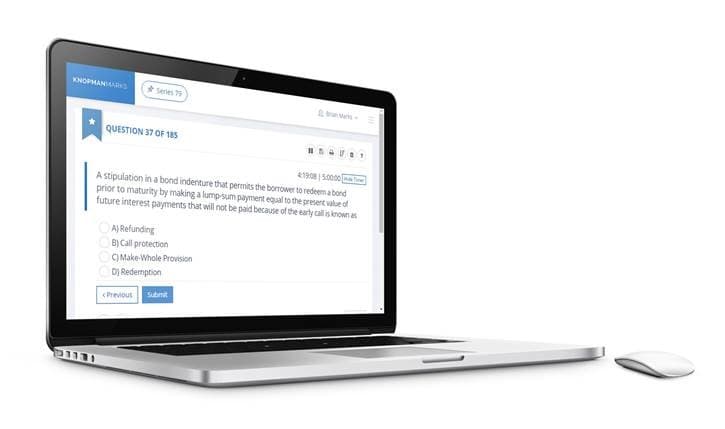
Learning by doing is learning at its best. Most agree that experiencing something firsthand goes far beyond just reading about it or hearing about it. This experiential learning theory definitely holds true when it comes to preparing for Series exams. Questions, questions, questions – they can make all the difference.
Don’t misunderstand — just doing a huge number of questions isn’t enough. Read on to learn best practices that can help ensure you are maximizing your time and learning at your peak when completing practice questions.
Pass the First Time Following these Q-Bank Guidelines
Use the best question bank tool you can get.
More isn’t always better. The way questions are written and how well they represent the tested body of knowledge is critical. Make sure you are using a test bank that has a proven success record. Here’s where I have to brag a little – Knopman Marks has the industry’s best pass rates. Why? One reason is the quality of its Q-banks. It engages industry experts to write questions – persons that have a history of dissecting content outlines and understanding the approach that regulators use. The more representative the questions, the more prepared you will feel. While questions are never exact representations (not possible in the way these tests are created) a high quality test bank will subject you to fewer surprises when you test.
Design and follow a strategy for improving your practice test scores.
Avoid a random approach to completing questions. While the best approach for any one individual differs by a number a factors including background knowledge, time prior to testing, and other factors, a good strategy for most persons is below:
- Start by completing short exams on each topic or chapter in the Q-bank. For example, in the Knopman Marks Q-bank, the Series 7 is broken down into 17 chapters. Starting with the first chapter, do a 30 question exam (as time permits), Advance to the next chapter only after scoring 70% or higher. When doing these exams, ensure that you choose the setting that allows you to review the rationale immediately after you have completed the question, and make sure you read it whether you got the question right or wrong. If the concept is still unclear, take time to go back to the book using the text reference in the rationale. This will help you understand the concept in context, which will strengthen your understanding measurably. Be careful not to complete all the questions in these initial quizzes as you want to save some new questions for the all topic exams.
- After going through all chapters and achieving the 70% target scores, turn your attention to exams on all topics. Turn off the “see rationale setting” and also choose the exam setting that keeps you from seeing questions that you’ve already completed. The more new questions you see, the better. Attempt an exam of all topics that is equal in length to the actual test (exception for Series 7 – just do 130 questions since you have two segments). This will give you a good indication of where you really are, and what it’s like to stay focused on the material for the actual length of the test. This takes real endurance!!
- At the end of the exam, review your score by topic. Before doing more exams on all topics, take time to remediate your areas of weakness. In the topical breakdown, look for topics where your score was less than 65%. Do 20 – 30 questions on each of these topics (reviewing the rationale as you go to strengthen your knowledge). Then do more practice tests.
- Keep doing practice tests on all topics to bring your score up to 80%+.
The instructors at Knopman Marks can give you guidance on the best possible strategy for you. Never hesitate to get in touch with us to discuss how the best possible approach for you. Also, check out the “At-A-Glance” Guides to help you put your strategy together. These guides give you key insights to map out a successful process.
Achieve the target scores recommended before you test.
To make passing your exam a sure thing, you can take no chances with your practice exam scores. Knopman Marks provides guidance for the scores must achieve and the minimum number of questions to complete prior to testing in “At-A-Glance” guides. Make every effort to follow this guidance before you test. If you are substantially below the target, you may wish to consider class attendance to help clarify the elusive material. On-demand classes are a great option for learning at your own pace, but live classes are super if you can manage to attend. Remember, if you’ve registered for a live class, you may come back more than once for all or part of the sessions.
Now go work more questions, and let us know if we can help you! We always appreciate any comments or feedback about our materials and your experience with us. Please stay in touch at material@knopman.com.
Written by Marcia Larson
Marcia Larson is Vice President, Faculty, at Knopman Marks Financial Training, New York, NY. She has extensive experience in financial licensing and regulatory training, having authored, developed and presented courseware for numerous securities and insurance exam preparation and continuing education and compliance programs. Before joining Knopman Marks, Marcia was Director of Annuity Products and Business Development at CUNA Mutual Group, where she developed and marketed industry-leading annuity products and retirement solutions and implemented distribution relationships. She was previously VP, Securities Products for Kaplan Financial, managing securities training products and subsequently, international training and businesses development. Marcia has trained thousands of financial industry exam candidates throughout their careers, and also college students as an adjunct professor. Marcia was a summa cum laude graduate of Wartburg College with degrees in Business Administration and Piano Performance. Marcia also holds the designations of Chartered Financial Consultant® (ChFC®), Chartered Life Underwriter (CLU®), Certified Employee Benefit Specialist (CEBS), and Fellow Life Management Institute™ (FLMI®). She currently teaches the SIE, Series 6, 7, 24, 50, 52, 63, 65, and 66 exams.
Related posts
- Read more
Exam Tips to Perform Under Pressure
High-stakes securities exams such as the SIE, Series 65, Series 79, or Series 24 can feel overwhe
- Read more
Efficient Exam Prep for Busy Professionals: Strategy Advising
Studying for a high-stakes securities exam like the Series 24 or Series 79 isn’t just about putti
- Read more
Crush the SIE Exam with the Video Vault
Are you feeling overwhelmed by the sheer volume of Securities Industry Essentials (SIE) exam cont


